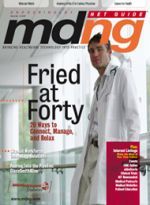Publication
Article
MDNG Endocrinology
TechSectors (Hardware): The Remote Presence Robotic System
We profile InTouch Technologies' Remote Presence (RP) robotic system, a modern-day
InTouch Technologies created the Remote Presence (RP) robotic system years ago, enabling “healthcare professionals to provide more effective and efficient healthcare by allowing them to 'be in two places at once.'" Standing at 5'5" with a price tag of $4,000-7,000 per month, the RP robot is guided by a joystick from a computerized ControlStation, typically located at a physician’s home or office, through the Internet and an 802.11 wireless network. It is equipped with a flat-screen computer monitor that displays the physician’s face, infrared warning sensors to avoid bumping into people or objects, and two-way cameras, microphones, and wireless technology that allow the physician to review the patient’s chart, lab work, and x-rays without being at the hospital. MDNG had the opportunity to speak with Yulun Wang, PhD, chairman and CEO of InTouch, about the RP robotic system, upcoming improvements, and physician and patient feedback.
Dr. Wang explained that his inspiration for creating the RP robot was based on his knowledge about robots and the healthcare industry and problems associated with the overall delivery of healthcare. He said these problems are “created by our aging population where the demands on healthcare are [increasing] dramatically [and] healthcare resources are shrinking simultaneously, so you have this perfect storm happening.” To provide quality healthcare at lower cost in facilities short on physicians, InTouch merged robotics, the Internet, and wireless technology to better leverage available healthcare resources.
InTouch is focusing on four scenarios in which the RP robot can assist hospitals and physicians:
- Shortage of intensivists — “There’s a big shortage of intensivists and there’s a lot of literature that says if intensivists monitor ICU patients on a 24/7 basis, it greatly helps to reduce costs and reduce morbidity and to reduce mortality and length-of-stay,” said Dr. Wang. “Since you can’t hire the intensivists, you get better outcomes if you leverage this technology.”
- Shortage of specialty specific physicians in the emergency department (ED) — “Hospitals are struggling to be able to have what’s called the call-panel for their staff ,” Dr. Wang explained. “When a patient comes into the ED and needs a consult from an orthopedist, cardiologist, neurologist, or general surgeon, hospitals are using these robots in order to enable these specialists to beam in because often it can take hours for the specialist to get to the ED.”
- Outreach — “The system [can] connect a larger hospital to a smaller hospital that doesn’t have all of the expertise it needs. It brings the expertise into these outlying rural communities."
- Supplemental Rounds — “When physicians are rounding on patients, [they] typically stop by once for maybe fi ve minutes in the day. Our system allows the physicians to easily come back and see the patient again from their clinic or their home for whatever reason—a new test result could be back, the family members could be there who also wanted to talk to the doc, or [if] discharge is possible,” Dr. Wang said.
Feedback on the RP robot has been encouraging. In 2004, Johns Hopkins conducted a study using the RP-6 to determine how comfortable patients were with being treated by their physician through a robot and found that “many hospitalized patients prefer visits from their own physician to those of the physicians on duty, even when those ‘visits’ are virtual ‘telerounds’”. Physicians who use the RP robots find that they are more efficient in their medical practice. Dr. Wang told MDNG, “They can actually be in their clinic, [with] five minutes between patients, and go see their hospital-based patients and get something else done in a period of time they otherwise wouldn’t be able to. In fact, I got an e-mail from the Chairman of Surgery from the Los Angeles Children’s Hospital who was at a conference in India and he rounded on a patient in LA.”
Already on its seventh-generation robot (RP-7), InTouch is currently working on improvements for both the robot and the control station, including creation of a kit that Dr. Wang said “can make virtually any computer into a control station [which provides] more and more flexibility” for the physician. Regarding the robot, the developers are looking to expand functionality by offering a stethoscope and otoscope, giving physicians greater capabilities.
Said Dr. Wang, “The need to better leverage medical expertise is a common problem everywhere in the world. The opportunity for us, we believe, is with every hospital in the world. Obviously things evolve and take time in order to move from larger places to smaller places, and also the Internet has to be there. Given that that evolution is undoubtedly going to take place, I think that it will happen with this technology as well."
Additional Resources
- I, Robot, MD
- Robot on the NBC TV Show "ER"


FDA Approves Crinecerfont for Congenital Adrenal Hyperplasia



